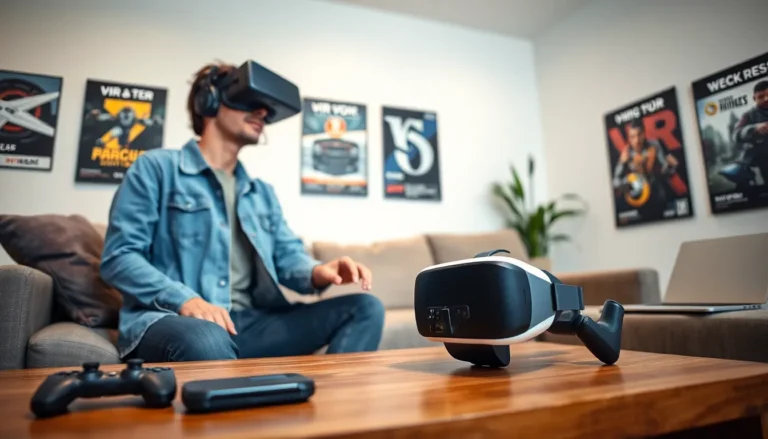In a world where attention spans are shorter than a cat meme’s lifespan, mobile app engagement is the holy grail for developers and marketers alike. Imagine your app as the life of the party, effortlessly pulling users in and keeping them entertained while they sip their virtual cocktails. With the right strategies, it can transform from a forgotten icon on a home screen to the must-have app everyone’s talking about.
Table of Contents
ToggleUnderstanding Engagement in Mobile Apps
Engagement in mobile apps captures user interaction and satisfaction. It reflects how frequently and meaningfully users connect with an app.
Defining User Engagement
User engagement encompasses actions like app visits, time spent, and repeated interaction. Measuring these actions provides insights into user behavior. High engagement indicates users find value. Features like push notifications and in-app messaging enhance interaction levels. Users who engage frequently often develop a sense of loyalty to the app. Engaged users frequently share their experiences, extending the app’s reach through word-of-mouth.
Importance of Engagement Metrics
Engagement metrics serve as key performance indicators for mobile apps. Metrics such as daily active users and session lengths reveal app relevance. These measurements highlight user satisfaction trends. Consistently analyzing engagement helps pinpoint areas for improvement. Understanding these metrics empowers developers to make data-driven decisions, optimizing user experience. Effective strategies enhance engagement and drive app success.
Strategies to Increase Engagement in Mobile Apps

Enhancing engagement in mobile apps requires targeted strategies that focus on user experiences and satisfaction. Developers can implement various techniques to retain users and encourage frequent interactions.
User Onboarding Processes
A well-designed onboarding process sets the tone for user engagement. Effective tutorials and guided tours help users navigate the app’s features quickly. Clear instructions promote usability from the first interaction. Engaging welcome messages can foster positive initial impressions. Using progress indicators keeps users informed of their journey, encouraging them to complete onboarding. Flexible onboarding options, such as skipping or revisiting tutorials, accommodate different user preferences.
Personalized User Experiences
Personalization improves user satisfaction significantly. Tailoring content based on user preferences creates a sense of relevance. Dynamic recommendations based on previous interactions cater to individual interests. Implementing user profiles allows for customized settings and notifications. Providing targeted push notifications based on user behavior enhances engagement. Leveraging analytics helps identify trends, enabling developers to refine personalization strategies continuously.
Gamification Techniques
Gamification techniques transform ordinary app experiences into exciting ones. Integrating challenges and rewards motivates users to engage more regularly. Users respond positively to progress tracking that visually represents their achievements. Leaderboards foster competition, encouraging users to interact frequently. Incorporating badges or virtual rewards for reaching milestones increases user satisfaction. These techniques create a playful environment, driving user loyalty and sustained interactions.
Role of Push Notifications
Push notifications play a crucial role in enhancing user engagement within mobile apps. They serve as direct communication tools, delivering timely updates and personalized messages that draw users back into the app.
Types of Push Notifications
- Transactional Notifications: These notifications provide users with essential updates related to their transactions, such as confirmations and receipts.
- Promotional Notifications: These alerts highlight special offers, discounts, or new features available within the app, encouraging users to take action.
- Reminder Notifications: These reminders prompt users about upcoming events, deadlines, or activities they expressed interest in, reinforcing engagement.
- Survey and Feedback Notifications: These encourage users to share their thoughts on app experience, gathering valuable data for future improvements.
- Location-Based Notifications: These alerts target users based on their geographic location, providing relevant content or offers when users are nearby.
Best Practices for Push Notifications
- Personalization: Customize notifications based on user preferences and behaviors to increase relevance and engagement.
- Segmentation: Target specific user groups with tailored messages that resonate with their unique needs and interests.
- Timing: Send notifications at optimal times to ensure users receive messages when they’re most likely to engage with the app.
- Frequency: Maintain balance in messaging frequency to avoid overwhelming users, which can lead to increased opt-outs.
- Clear Call-to-Action: Include concise and compelling calls-to-action that guide users on the next steps to maximize engagement.
Analyzing User Feedback
User feedback plays a vital role in understanding app performance and driving engagement. Collecting user insights allows developers to refine features and enhance user experiences.
Methods for Collecting Feedback
Surveys and polls offer direct avenues for obtaining user feedback. In-app ratings prompt users to share experiences seamlessly during their interaction. Another method involves social media channels, where users openly discuss their thoughts about the app. User forums create an interactive space where ideas and concerns are shared. Analytics tools track user behavior and interactions, providing indirect feedback through engagement metrics. Combining these methods leads to a comprehensive understanding of user satisfaction.
Implementing Changes Based on Feedback
Identifying trends in feedback allows developers to prioritize updates effectively. When significant issues arise, addressing those promptly can transform user experience. Implementing changes based on feedback fosters a sense of community and encourages continued interaction. Developers should communicate updates clearly to users, highlighting how feedback was incorporated. Testing new features with select users can gauge their effectiveness before a wider release. Continually analyzing feedback ensures the app evolves alongside user needs, boosting engagement and satisfaction.
Increasing engagement in mobile apps is vital for success in today’s competitive landscape. By focusing on user experience and satisfaction developers can create environments that keep users coming back. Implementing strategies like personalized content gamification and effective onboarding can significantly enhance user interaction.
Moreover utilizing push notifications and actively seeking user feedback allows developers to adapt and improve their apps continuously. This commitment to understanding user needs and preferences not only boosts engagement but also cultivates loyalty. As developers embrace these practices they position their apps to thrive in an ever-evolving digital ecosystem.




